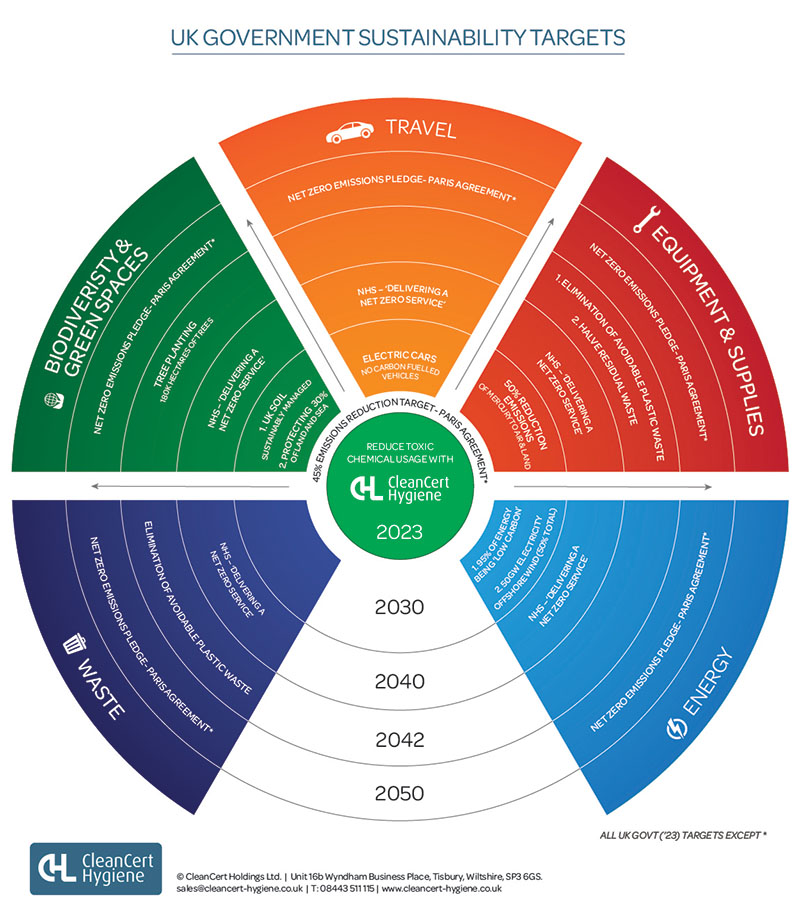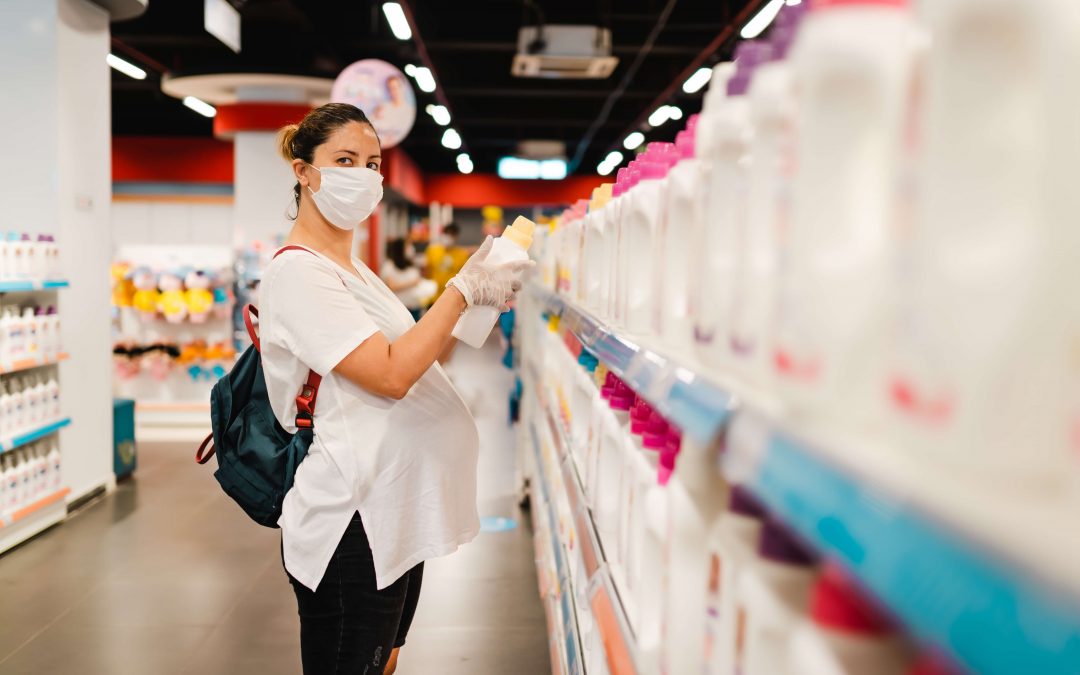(1129 words) Published Sept ’22, Updated May ’23
‘Sustainability’ is a growing theme across all areas of clinical treatment – but what impact does it have on the daily lives of front-line staff, especially nurses? Here, Simon Davies, founder of CleanCert Hygiene, continues his ‘Green Solutions’ series, focusing on how eco-friendly products minimise environmental impact today, whilst delivering higher performance.
Wikipedia defines biomimetics as “the emulation of the models, systems, and elements of nature for the purpose of solving complex human problems”. Some of the most ubiquitous technologies in the world today mimic nature to achieve their success. By copying the formation, structure, or function of living organisms, biomimetics synthesise similar products and systems using artificial means. One biomimetic compound increasingly used in dentistry and hospitals (hypochlorous) is not only inspired by nature; it also helps to protect it.
Velcro fabric is one of the oldest and most widely used biomimetic technologies. Its inventor, George de Mestral, was inspired to create it after studying the prickly plant burrs that clung to his dog’s fur. Other examples include the blades of wind turbines, which mirror the aerodynamic efficiency of humpback whale fins, and a recently approved surgical glue based on the secretions of the Californian sandcastle worm. Many biomimetic products are inspired by plants, including water-, oil- and fat-repelling sprays, coatings and sealants that copy the nanoscale surface of the lotus leaf.
Overcoming the challenges of bioaccumulation
Clinical staff and nurses in particular are asked to handle disinfectants many times each day, hence need to be aware of the latest evidence around environmental impact.
One of the ways in which the disinfectant chemicals we use damage the natural world and living organisms is through the process of bioaccumulation. This is where contaminants and chemicals dissolve into water, evaporate into the air and mix into soils, whereby they are ingested or absorbed by plants and animals. In high enough concentrations, certain contaminants can build up and accumulate in the tissues of living things- aka bioaccumulation¹. Often crucial bioaccumulation data takes a long time to build up, by which time the products have become normalised through frequency of exposure.
The problems with quats in particular
Humans have a questionable record when it comes to their choices of disinfectants. In Italy in the 15th century, mercury derivatives were used to combat an outbreak of syphilis. ² Mercuric chloride was still being used as an antiseptic in the late 1950s, before suggestions that exposure to it was dangerous for humans. We now know, of course, that mercury is highly toxic and can bioaccumulate in humans to cause serious long-term health risks.
Another group of modern chemicals, known as quaternary ammonium compounds (QACs or quats), are one of the most widely used disinfectant molecules that we have been using since the early 20th century. Their antimicrobial properties mean they are widely used in clinical treatment, found in surface disinfectant wipes and sprays. In dentistry they are found in composite resin, adhesive systems, acrylic resin, glass ionomer cement and endodontic materials. Across all these applications, QACs play an important role: they promote antimicrobial activity, decrease bacterial attachment in the enamel and prevent biofilm accumulation. But increasing evidence is pointing to emerging risks and since 2016, the use of QACs in consumer hand and body washes throughout the European Union has begun to be limited.³
These chemicals have been detected in wastewater, surface waters, and sediments. ⁴ They have been shown to reduce fertility in male and female mice. ⁵ Research published earlier this year found QACs in human milk for the first time. ⁶ The researchers concluded that this represents potential risk to babies, warranting further research on the toxicity of QACs and their effect on human health. The repeated use of QACs has been shown to result in them bioaccumulating in human blood, ⁷ with levels appearing to increase as a result of heightened disinfectant use during the COVID-19 pandemic ⁸. Another concern worth mentioning here is that bacteria are becoming resistant to QACs, with some biocides also appear to be inducing resistance to QACs.⁹
Eco friendly AND higher performance- CHL’s range (with HOCl) vs bleach
| Pathogen | Bleach or HOCl | PPM (based on test evidence) | Contact time for >2Log reduction |
|---|---|---|---|
| E.coli 11 | Bleach | 200 | 10 minutes |
| E.coli 12 | HOCl | 100 | 5 seconds |
| COVID-19 13 | Bleach | 1,000 | 1 minute |
| COVID-19 14 | HOCl | 62 | 30 seconds |
| Salmonella 15 | Bleach | 100 | 1 minute |
| Salmonella 16 | HOCl | 100 | 5 seconds |
| Mycobacterium tuberculosis 17 | Bleach | 10,000 | 1 minute |
| Mycobacterium tuberculosis 18 | HOCl | 80 | 30 seconds |
| Norovirus 19 | Bleach | 5,000 | 3.2 minutes |
| Norovirus 20 | HOCl | 50 | 1 minute |
| Avian Bronchitis 21 | Bleach | 5,000 | 30 minutes |
| Avian Bronchitis 22 | HOCl | 62 | 30 seconds |
Non- bioaccumulative products are available now!
Innovative ways to use products with safer and more sustainable chemicals – often those that mimic nature – have environmental benefits, including being non-bioaccumulative to staff and patients. The added bonus is they can be even more powerful (shorter contact time) than their toxic competitors.
One disinfectant biomimetic is produced by the white blood cells of the human immune system in response to infection – and is called hypochlorous. It can eliminate biofilms and free-floating viruses, bacteria, and fungi more effectively than bleach. It has been independently verified as effective in destroying SARS-CoV-2, the novel coronavirus that causes COVID-19. HOCl is used in different formulations for a number of human (oral, skin,ocular) and clinical surfaces (water, medical devices etc) at CleanCert Hygiene (CHL)- both as medical devices and biocides.
This naturally occurring substance is completely non-cytotoxic, non-mutagenic and does not cause reproductive toxicity. It does not irritate the mucosa, skin or eyes and can even be swallowed without causing harm (up to 7500ml). As a result, clinical staff do not need to use personal protective equipment (PPE) to handle the products, making them perfect for immediate use by front line clinical staff today.

SteriDerm skin disinfectant (100ml, 250ml, 1L & 5L), CleanCert waterline disinfectant (5L), OptiZil surface cleaner (1L spray and 5L), OraWize+ mouthwash (250ml, 1L & 5L)
Simon Davies is founder and Commercial Director of Tec Safe, a dental company that specialises in developing easier and safer decontamination products for a wide variety of dental applications, using eco-friendly solutions.
Visit the website: www.tec-safe.com
For further info, please email: sales@cleancert-hygiene.co.uk
References
- Borgå, K. 2013. Ecotoxicology: Bioaccumulation. Reference Module in Earth Systems and Environmental Sciences
- Sabbatani, 2016. – Syphilis in 16C Bologna. Infez. Med.
- Pereira et al.2019. Benzalkonium Chlorides: Uses, Regulatory Status, and Microbial Resistance. Applied and Environmental Microbiology 85(13
- Hora et al. 2020. Increased Use of Quaternary Ammonium Compounds during the SARS-CoV-2 Pandemic and Beyond: Consideration of Environmental Implications. Environ. Sci. Technol. Lett. 7(9):622–631
- Melin et al. 2016. Quaternary ammonium disinfectants cause subfertility in mice by targeting both male and female reproductive processes. Reproductive Toxicology 59:159-166.
- Zheng, Get al. 2022. The first detection of quaternary ammonium compounds in breast milk: Implications for early-life exposure. J Expo Sci Environ Epidemiol.
- Zheng, G et al. 2021. Quaternary Ammonium Compounds: Bioaccumulation Potentials in Humans and Levels in Blood before and during the Covid-19 Pandemic. Environ Sci Technol 55(21):14689–14698.
- Chen, B. et al. 2021. Biocide-tolerance and antibiotic-resistance in community environments and risk of direct transfers to humans: Unintended consequences of..Covid 19. Environmental Pollution 283;117074
- Han et al The impact and mechanism of quaternary ammonium compounds on the transmission of antibiotic resistance genes Environ Sci Pollut Res Int. 2019 Sep
- Regulation (EU) No 528/2012 BPR/ECHA. Evaluation of active substances ‘20
- Rossoni, E. M. M., & Gaylarde, C. C. (2000). Comparison of sodium hypochlorite and peracetic acid as sanitising agents for stainless steel food processing surfaces using epifluorescence microscopy. International Journal of Food Microbiology, 61(1), 81–85. https://doi.org/10.1016/s0168-1605(00)00369x
- HAKIM, H., ALAM, Md. S., SANGSRIRATANAKUL, N., NAKAJIMA, K., KITAZAWA, M., OTA, M., TOYOFUKU, C., YAMADA, M., THAMMAKARN, C., SHOHAM, D., & TAKEHARA, K. (2016). Inactivation of bacteria on surfaces by sprayed slightly acidic hypochlorous acid water: in vitro experiments. Journal of Veterinary Medical Science, 78(7), 1123–1128. https://doi.org/10.1292/jvms.16-0075
- Henwood, A. F. (2020). Coronavirus disinfection in histopathology. Journal of Histotechnology, 1–3. https://doi.org/10.1080/01478885.2020.1734718
- Nguyen, K., Bui, D., Hashemi, M., Hocking, D. M., Mendis, P., Strugnell, R. A., & Dharmage, S. C. (2021). The Potential Use of Hypochlorous Acid and a Smart Prefabricated Sanitising Chamber to Reduce Occupation-Related COVID-19 Exposure. Risk Management and Healthcare Policy, 14, 247–252. https://doi.org/10.2147/RMHP.S284897
- Byun, K.-H., Han, S. H., Yoon, J., Park, S. H., & Ha, S.-D. (2021). Efficacy of chlorine-based disinfectants (sodium hypochlorite and chlorine dioxide) on Salmonella Enteritidis planktonic cells, biofilms on food contact surfaces and chicken skin. Food Control, 123, 107838. https://doi.org/10.1016/j.foodcont.2020.107838
- HAKIM, H., ALAM, Md. S., SANGSRIRATANAKUL, N., NAKAJIMA, K., KITAZAWA, M., OTA, M., TOYOFUKU, C., YAMADA, M., THAMMAKARN, C., SHOHAM, D., & TAKEHARA, K. (2016). Inactivation of bacteria on surfaces by sprayed slightly acidic hypochlorous acid water: in vitro experiments. Journal of Veterinary Medical Science, 78(7), 1123–1128. https://doi.org/10.1292/jvms.16-0075
- Best, M., Sattar, S. A., Springthorpe, V. S., & Kennedy, M. E. (1990). Efficacies of selected disinfectants against Mycobacterium tuberculosis. Journal of Clinical Microbiology, 28(10), 2234–2239. https://doi.org/10.1128/jcm.28.10.2234-2239.1990
- http://hocl.io/pdf/SMS2009.pdf
- Park, G. W., & Sobsey, M. D. (2011). Simultaneous Comparison of Murine Norovirus, Feline Calicivirus, Coliphage MS2, and GII.4 Norovirus to Evaluate the Efficacy of Sodium Hypochlorite Against Human Norovirus on a Fecally Soiled Stainless Steel Surface. Foodborne Pathogens and Disease, 8(9), 1005–1010. https://doi.org/10.1089/fpd.2010.0782
- https://ewco.com/pdf/nvstudy2.pdf
- Abe, M., Kaneko, K., Ueda, A., Otsuka, H., Shiosaki, K., Nozaki, C., & Goto, S. (2007). Effects of Several Virucidal Agents on Inactivation of Influenza, Newcastle Disease, and Avian Infectious Bronchitis Viruses in the Allantoic Fluid of Chicken Eggs. Original Article Jpn. J. Infect. Dis, 60, 342–346. https://www.niid.go.jp/niid/images/JJID/60/342.pdf
- Miyaoka, Y., Kabir, Md. H., Hasan, Md. A., Yamaguchi, M., Shoham, D., Murakami, H., & Takehara, K. (2021). Virucidal activity of slightly acidic hypochlorous acid water toward influenza virus and coronavirus with tests simulating practical usage. Virus Research, 297, 198383. https://doi.org/10.1016/j.virusres.2021.198383
